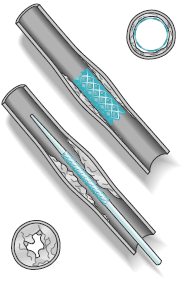Access Menu
What is a stent?
A stent – sometimes called an endoprosthesis – is a small, flexible tube made of medical grade plastic or wire mesh. It is implanted in the body to treat a variety of medical conditions.
What conditions can be treated with stents?
Stents are used to treat a number of medical conditions:
 Stents are most commonly used to hold clogged blood vessels open after angioplasty, a procedure in which a balloon on the end of a catheter is moved through the body to the site where the blood vessel is blocked. The balloon is then inflated to open the vessel. In some cases, however, stents may be placed as the primary means for holding the vessel open. Stents also are used to hold open bile ducts or other pathways in the body that have been narrowed or blocked by tumors or other obstructions. Areas where stents are most often used for this reason include:
Stents are most commonly used to hold clogged blood vessels open after angioplasty, a procedure in which a balloon on the end of a catheter is moved through the body to the site where the blood vessel is blocked. The balloon is then inflated to open the vessel. In some cases, however, stents may be placed as the primary means for holding the vessel open. Stents also are used to hold open bile ducts or other pathways in the body that have been narrowed or blocked by tumors or other obstructions. Areas where stents are most often used for this reason include:- the esophagus, to treat blockages or narrowings that make it difficult to swallow;
- the bile ducts in the pancreas or liver, when an obstruction prevents bile from draining into the digestive tract; and
- the airways of the lungs, to treat obstructions that interfere with normal breathing.
In some cases, stents are used to treat patients with severe liver disease. These patients often experience life-threatening bleeding because their livers are too damaged to handle the normal flow of blood. One way to treat this condition is with a technique called TIPS, in which a stent is used to create a connection between two veins and divert the flow of blood away from the liver.
How are stents implanted in the body?
The interventional radiologist makes a very small incision in the skin, about the size of a pencil tip. The stent, which is placed on the end of a catheter, is threaded under X-ray guidance to the area of treatment. This interventional radiology technique is generally less traumatic for the patient than surgical implantation because it involves smaller incisions, less pain and shorter hospital stays.